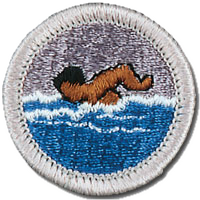The Swimming merit badge is one of the most popular and important badges a Scout can earn. As one of the Eagle-required fitness badge options—alongside Hiking and Cycling—it provides Scouts with essential water safety and swimming skills that can save lives and promote long-term health.
This badge is about more than just physical fitness; it reinforces safe habits around water, rescue techniques, and how to swim efficiently using a variety of strokes. Whether you swim for fun, fitness, or safety, this badge will sharpen your skills and help prepare you for any aquatic environment.
Timeframe / Difficulty
The Swimming merit badge is moderately challenging and can usually be completed in 2–4 weeks if the Scout is already a confident swimmer. For those needing more practice with strokes or endurance, expect to take 1–2 months.
Access to a pool or lake, along with an experienced counselor and consistent practice, is key to earning this badge smoothly. Much of the badge can be completed during Scout summer camps or aquatic merit badge weekends.
Tips for Success
1. Practice your strokes ahead of time.
Work with a swim coach, parent, or merit badge counselor to refine your technique, especially for strokes like sidestroke and elementary backstroke.
2. Review Safe Swim Defense early.
Understand this core Scouting safety policy—it applies to every aquatic activity and will help you earn this badge and lead safe troop outings.
3. Build up endurance gradually.
Even if you know all the strokes, swimming 150 yards with correct form takes energy and control. Practice in segments, then combine strokes as required.
Complete Guide to the Swimming Merit Badge
This guide is only intended as a starting point for your research. Directly copying the information offered here is plagiarism. Doing your own research will allow you to get the most out of this badge and maintain the 12 points of the scout law. A scout is trustworthy!
Below is a complete breakdown of each requirement for the Swimming merit badge, followed by tips and explanations to help you succeed.
Requirement 1
1. Do the following:
(a) Explain to your counselor how Scouting’s Safe Swim Defense plan anticipates, helps prevent and mitigate, and provides responses to likely hazards you may encounter during swimming activities.
(b) Discuss the prevention and treatment of health concerns that could occur while swimming, including hypothermia, dehydration, sunburn, heat exhaustion, heatstroke, muscle cramps, hyperventilation, spinal injury, stings and bites, and cuts and scrapes.
Tips:
- Study the BSA Safe Swim Defense and be ready to explain the eight points: qualified supervision, physical fitness, safe area, lifeguards/lookouts, ability groups, buddy system, discipline, and emergency action.
- For part (b), know how to treat each condition and recognize symptoms early. You can find resources in the First Aid merit badge pamphlet or the BSA Fieldbook.
Requirement 2
2. Before doing the following requirements, successfully complete the BSA swimmer test:
- Jump feetfirst into water over the head in depth.
- Level off and swim 75 yards in a strong manner using one or more of the following strokes: sidestroke, breaststroke, trudgen, or crawl.
- Then swim 25 yards using an easy, resting backstroke.
- The 100 yards must be completed in one swim without stops and must include at least one sharp turn.
- After completing the swim, rest by floating.
Tips:
- Practice swimming in a calm, steady pace—75 yards strong + 25 yards resting backstroke.
- Resting by floating is not optional—know how to float comfortably.
- Make sure you can complete this in one go without touching the bottom or stopping at the wall.
Requirement 3
3. Correctly perform the following strokes:
(a) Demonstrate the front crawl or the trudgen using good form.
(b) Demonstrate the back crawl using good form.
(c) Demonstrate the sidestroke using good form.
(d) Demonstrate the breaststroke using good form.
(e) Demonstrate the elementary backstroke using good form.
Tips:
- Practice proper form and breathing for each stroke.
- Watch video tutorials or swim with a coach to improve technique.
- Some great tutorials can be found on the Youtube channel Global Triathlon Network
- Front Crawl
- Back Crawl
- Sidestroke (Mr. Animate video)
- Breaststroke
- Elementary Backstroke (SwimLifePro Video)
- Some great tutorials can be found on the Youtube channel Global Triathlon Network
- Don’t rush—clean technique is more important than speed for this badge.
Requirement 4
4. Swim continuously for 150 yards in a strong manner using each of the following strokes in any order:
- Front crawl or trudgen (25 yards)
- Back crawl (25 yards)
- Sidestroke (25 yards)
- Breaststroke (25 yards)
- Elementary backstroke (50 yards)
Tips:
- This is an endurance test. Pace yourself.
- Combine what you practiced in Requirement 3 into one long swim.
- Use a pool with lane markers to help you stay straight and focused.
Requirement 5
5. Do the following:
(a) Demonstrate water rescue methods by reaching with your arm or leg, by reaching with a suitable object, and by throwing lines and objects.
(b) Explain why swimming rescues should not be attempted when a reaching or throwing rescue is possible, and explain why and how a rescue swimmer should avoid contact with the victim.
(c) With a helper and a practice victim, show a line rescue both as tender and as rescuer. The practice victim should be approximately 30 feet from shore in deep water.
Tips:
- Practice with throw bags, poles, towels, or even pool noodles.
- Emphasize “Talk, Reach, Throw, Row, Go” — in that order.
- Understand the risks of contact rescues and why drowning victims may panic.
Requirement 6
6. Do the following:
(a) Float faceup in a resting position for at least three minutes with minimal movement.
(b) Demonstrate survival floating for at least five minutes.
(c) While wearing a properly fitted U.S. Coast Guard-approved life jacket, demonstrate the HELP and huddle positions. Explain their purposes.
(d) Explain why swimming or survival floating will hasten the onset of hypothermia in cold water.
Tips:
- HELP = Heat Escape Lessening Posture. Use in cold water to reduce heat loss.
- Huddle = groups stay warmer and more visible.
- Know that movement increases heat loss, so staying still is key to surviving cold water.
Requirement 7
7. In water over your head, but not to exceed 10 feet, do the following:
(a) Use the feetfirst method of surface diving and bring an object up from the bottom.
(b) Do a headfirst surface dive (pike or tuck), and bring the object up again.
(c) Do a headfirst surface dive to a depth of at least 5 feet and swim underwater for three strokes. Come to the surface, take a breath, and repeat the sequence twice.
Tips:
- Practice picking up weighted objects like bricks or rings from the bottom.
- Build confidence diving and swimming underwater.
- Don’t forget to equalize pressure if diving deeper than usual.
Requirement 8
8. Following the guidelines set in the BSA Safe Swim Defense, in water at least 7 feet deep*, show a standing headfirst dive from a dock or pool deck. Show a long shallow dive, also from the dock or pool deck.
* If your state, city, or local community requires a water depth greater than 7 feet, it is important to abide by that mandate.
Tips:
- Learn both the vertical standing dive and the shallow glide dive.
- Only practice dives in areas designed for headfirst entries—safety comes first.
Requirement 9
9. Explain the health benefits of regular aerobic exercise, and discuss why swimming is favored as both fitness and therapeutic exercise.
Tips:
- Swimming is a full-body workout, builds endurance, and is low-impact.
- Explain how swimming helps heart and lung health, improves flexibility, and can aid in injury recovery.
Conclusion
The Swimming merit badge builds confidence, competence, and safety around water—an essential skill set for any Scout. Whether you’re preparing for high-adventure trips, camp activities, or just want to become a better swimmer, this badge provides life-saving knowledge and skills you’ll use far beyond Scouting.
If you’re working toward Eagle Scout, don’t miss our other required badge guides:
You can find the official Swimming merit badge requirements on Scouting.org.
Stay safe, swim strong, and dive into your next adventure!





